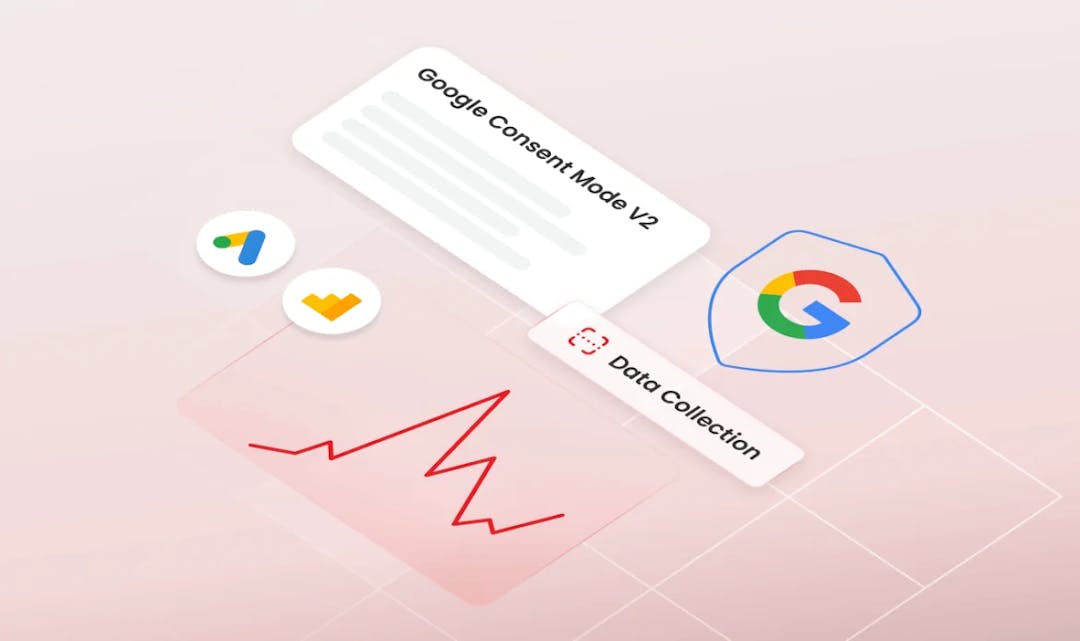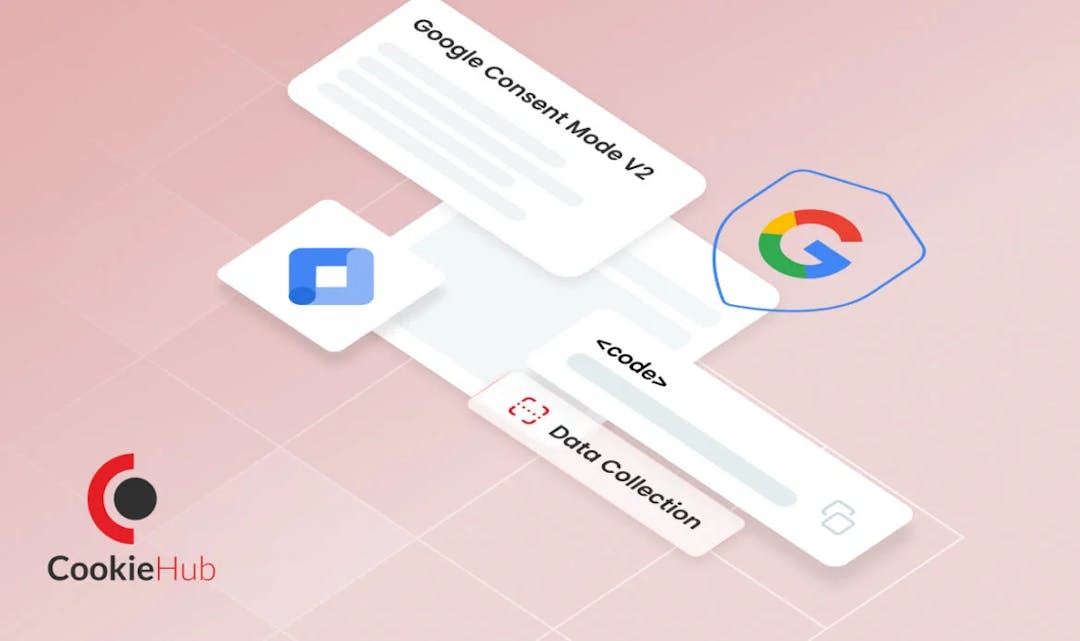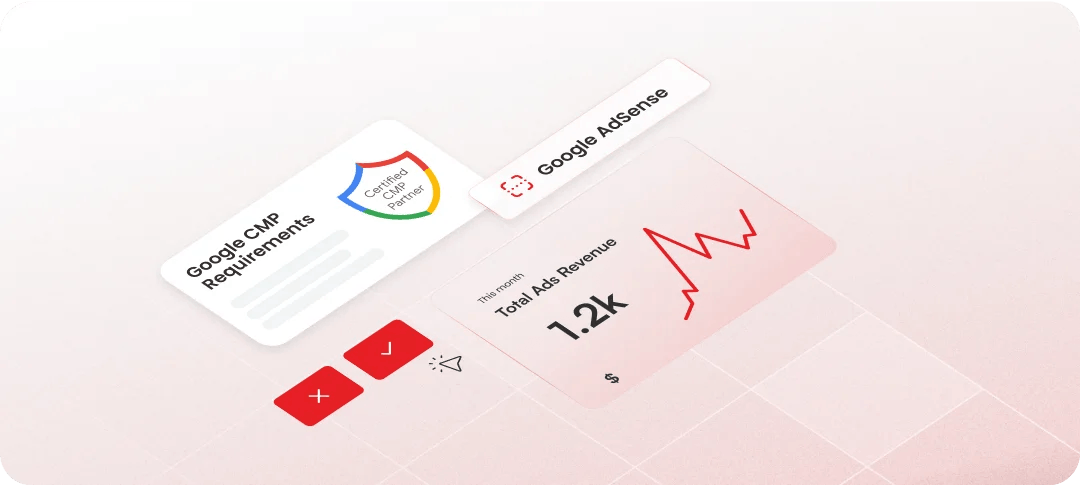Here’s how you can easily get started by activating Google Consent Mode in CookieHub:
To use Consent Mode v2 with CookieHub, ensure your platform is updated to version 2.8.0 or later. This version includes support for the new consent signals and integration capabilities with Google services.
Follow the steps in our detailed documentation to install Google Consent Mode with Consent Mode with Google Tag Manager. CookieHub offers a convenient Google Tag Manager template that comes with integrated consent mode support, making it easy and hassle-free to implement into your existing Google Tag Manager container.
If you’re not using Google Tag Manager (GTM) to integrate CookieHub, you can still enable consent mode v2 through the CookieHub dashboard by following the steps in the CookieHub documentation.
You can implement Consent Mode on your website or app using either of two methods – a basic or an advanced implementation.
Basic implementation: Prevents Google tags from loading until a user interacts with a consent banner. No data is transmitted to Google before user interaction. When the user consents, Google tags load and send the consent states to Google. If the user does not consent, no data is sent to Google, and tags are blocked from firing.
Advanced implementation: Google tags load when a user opens the website or app, setting default consent states (usually denied). The tags send cookieless pings until the user interacts with the banner. When consent is granted, the tags send full measurement data. This enables improved, advertiser-specific modeling compared to the basic implementation.
Ensure Google Consent Mode V2 is correctly implemented on your site.

Google Consent Mode is a tool that allows websites to adjust how Google services behave based on user consent. User consent is now table stakes for doing digital business – but there is balance to be struck between protecting user privacy and enabling non-intrusive, personalized advertising.
Better data, easier consent
Before Google Consent Mode, digital analytics data suffered from being not quite complete because tracking required explicit user consent before any data could be collected. But by integrating your Google-certified CookieHub CMP with Google Consent Mode, accurate insights and conversion measurements from Google Ads, Google Analytics, and Google Tag Manager are just a click away – and compliant with relevant data privacy policies.
Google Consent Mode is a must
As of early 2024, Google Consent Mode has been required to access measurement, ad personalization, and remarketing features for users in the European Economic Area and the UK. Aligning with Google’s EU user consent policy means you gather all this valuable data, even in the absence of consent.
Consent mode is designed to help advertisers and publishers comply with data privacy laws. It works by enabling users to specify their consent preferences for tracking and analytics before any data is sent to Google’s servers. Once consent preferences are set, consent mode determines which tags should be loaded, ensuring only authorized tags collect data.
Simple, seamless integration:
CookieHub’s user-friendly interface simplifies the integration process with Consent Mode v2 and any CMS and easily integrates with Google Tag Manager.
Work with a Google-certified CMP partner:
CookieHub is a Google-certified consent management platform (CMP)
Future-proof compliance:
Stay ahead of evolving data privacy regulations with automatic updates and ongoing support, automating consent management from scanning to cookie blocking to audits.
CookieHub is a trusted consent management platform (CMP) that helps you meet the latest data privacy requirements with ease. Automate consent collection, stay fully compliant, and keep your digital business running smoothly in Europe and around the world.
Safeguard your ad revenue through consent-forward, privacy-compliant marketing data and the opportunities it opens. CookieHub integrates seamlessly with Google Consent Mode and offers flexible customization to ensure you capture and transmit user consent with precision.
Create deeper trust and connections with users, and a more trustworthy user experience for your website visitors while maintaining flexible control over customization and design. Stand out among competitors and build trust to drive engagement and revenue.
Understanding the why and how behind Google Consent Mode doesn’t have to be hard – here are some of the most frequently asked questions to get to the heart of Google Consent Mode.
Google introduced the Consent Mode tool on September 3, 2020, as a way to bridge the gap between data privacy requirements and effective digital marketing. At its core, Consent Mode allows businesses to continue measuring website activity and ad conversions in a compliant manner even without explicit user consent, ensuring analytics remain valuable while respecting user choices. Since the introduction of stricter privacy regulations worldwide, such as the EU’s GDPR, organizations have been required to obtain user permission before collecting or processing personal information. That means nearly every website operator and data controller must take consent seriously. By integrating Google Consent Mode with CookieHub, companies can still gather reliable insights for their marketing teams without running afoul of data privacy laws. The result is a consent-driven model without undermining marketing efforts or business growth. From a technical standpoint, Google Consent Mode lets websites convey a user’s consent status directly to a website, enabling tags to adjust their behavior. Consent mode is integrated directly into a consent management platform, like CookieHub, to adapt the behaviors of Google solutions, such as Google Analytics, Google Ads, and other third-party tags based on user consent selections.
Google Consent Mode v2 is an update to the first generation Consent Mode that aims to respect user privacy and comply with the EU’s data privacy regulations. There are several critical differences between the old and new Google Consent Mode versions. Original Google Consent Mode: Optional and used to enable modeling A Google-certified CMP was optional Measurement only begins once users has consented via Google or third-party services Google Consent Mode v2: Consent Mode now required for tracking A Google-certified CMP is mandatory to be able to use Consent Mode Measurement only begins if the user has consented, and the corresponding signal has been received by Google via Google Consent Mode. (This will occur if your consent mode signals are correctly implemented.) New parameter inclusions: ad_user_data and ad_personalisation. These give websites the ability to manage and align with user consent preferences.
Consent Mode is a tool, an API, that receives users’ consent choices from your cookie banner or widget, dynamically adapting the behavior of Google Analytics, Google Ads, and third-party tags that create or read cookies. This feature preserves a visitor’s consent state across different pages they visit, ensuring consistent application of their choices. Consent Mode operates by adding an extra parameter to requests sent to Google’s servers, indicating user consent status for ad personalization and analytics. Initially, when no consent is given, Google receives limited information (e.g., IP address, page URL). Once consent is provided, the parameter updates to reflect the user’s choice, influencing subsequent data requests. What does this look like in practice? It can vary depending on whether you already use CookieHub or not, and whether you are using Google Tag Manager. Here are generic implementation steps; however, please refer to our Consent Mode documentation for detailed instructions. Create your consent banner Implement CookieHub CMP on your website Enable Consent Mode v2 Get the data and insight you need thanks to Consent Mode
Consent Mode introduces two tag settings – one for cookie management for analytics (analytics_storage) and the other for cookie management for advertisement (ad_storage). Google Consent Mode v2 adds two more tag settings – one for consent for sending user data to Google for online ad purposes (ad_user_data), and the other to set consent for personalized advertising (ad_personalization). analytics_storage Google Consent Mode regulates analytics cookies in relation to user consent with the analytics_storage tag. Google Analytics adjusts the collection of data based on user’s consent. When consent is withheld, your site will still receives basic and non-identifying measurement data, including timestamps of site visits, whether users landed on your site, see how a user landed on your page, and so on. ad_storage Google Consent Mode manages marketing cookies on your site based on user consent using the ad_storage tag. Without user consent to marketing or advertising cookies, Google’s Consent Mode will not use these marketing cookies. Instead your site will still be able to display contextual ads based on anonymous data, not targeted, personal advertising. Google Consent Mode enables your site to record and measure conversions in aggregate to offer some insight to website owners while still ensuring GDPR compliance and enhanced marketing performance despite the missing individual-level data. Google Consent Mode also adapts Google tags’ behavior based on the user’s region, so if certain cookies may be set without consent for US users, for example, but the same cookies would require consent from EU users, Google Consent Mode handles this. ad_user_data In Google Consent Mode v2, users give grant permission for their data to be collected and used specifically for ads. The parameter ad_user_data governs this. This consent covers things like demographic information, browsing behavior, and interaction with ads. Granting this consent, users allow Google to gather and analyze their data to enhance the relevance of the advertisements they see across the web. ad_personalization The tag ad_personalization related to advertisements being customized to target users based on their preferences and behavior. This consent gives Google the permission to use users’ data to personalize the ads they see across Google’s services and the broader internet – both to serve relevant display ads and to irrelevant or repetitive ads. This tag is important for enabling a tailored online ad experience for users.
Any business using Google ad and analytics services should consider Consent Mode important. More specifically, Consent Mode is most relevant for publishers, advertisers, marketing agencies and teams, web agencies, and any companies that implement consent banners and use Google Analytics and Google Ads. For advertisers, Consent Mode enables effective tracking of ad performance and better insight into ad campaign spend to improve ad bidding strategies. For marketers, Consent Mode allows for the continued collection of important user data in order to continue gathering and using insights that help deliver better marketing results. For website operators and owners, Consent Mode can facilitate a better understanding of user journeys and conversions on their sites.
Google Consent Mode helps improve conversions and ad campaign performance in the following ways: Preserves measurement accuracy Even if users decline certain cookies, Consent Mode uses modeling to fill gaps in conversion data. This means you still see accurate reports of how ads are performing, without losing insights due to consent restrictions. Improves conversion tracking With consent signals, Google Ads and Analytics know whether they can use cookies. If cookies aren’t allowed, Consent Mode sends cookieless pings to keep tracking essential actions (like purchases or sign-ups). Better campaign optimization By recovering conversion data with modeling, Google Ads’ machine learning has more complete information. This helps Smart Bidding optimize campaigns more effectively, leading to higher ROI. Compliance + performance balance You remain GDPR and ePrivacy compliant while still keeping campaign insights. This avoids the common trade-off of either respecting consent or losing conversion data.
There are a number of ways to tell if Consent Mode is activated. If you are using a Google-certified CMP, which you should be, there should be a dashboard or setting that confirms Consent Mode is firing correctly. With CookieHub’s Consent Mode Checker, you can check whether Consent Mode is implemented properly.
Not every jurisdiction in the world is subject to a data privacy regulations that make Google Consent Mode essential. But for the most part, locations that do impose data protection regulations place demanding rules on how user data is collected, processed, and managed. In particular, GDPR in the EU and the EU User Consent Policy (a Google policy that requires Google users to disclose cookie use on their websites and apps to get user consent) are particularly relevant to Google Consent Mode. Note that using Google Consent Mode does not make a website or app GDPR (or any other data privacy regulation) compliant.
As of 2024, Google Consent Mode has been required if you collect and process user data and serve Google ads to users in the European Economic Area.
If your business is collecting and processing user data and serve Google ads to users in the European Economic Area, Google Consent Mode must be used.
At the most basic level, a Google-certified CMP (consent management platform) has been officially approved by Google to integrate with Consent Mode v2, ensuring compliance with Google’s ad and analytics requirements. What does it mean to be a certified CMP Google Partner? Google puts its certified partners through a rigid vetting process, evaluating a platform’s capability to manage user consent effectively, with particular attention paid to its abilities vis-à-vis Google’s advertising and analytics services. Platforms that achieve certification status have shown an adherence to industry best practices in data privacy. Certified CMP Google Partnership serves as the benchmark for websites, assuring users and businesses of a platform’s proficiency in handling consent management meticulously. A non-certified CMP may still collect and manage consent but isn’t verified by Google, so it might not fully support Consent Mode v2 or guarantee compatibility with Google Ads and Analytics.
Yes, CookieHub is proud to be a Google-gold certified content management platform.
An Easy Guide to Google Consent Mode V2

The launch of Google Consent Mode v2 signifies a major step in Google’s attempts to balance the needs of advertisers to collect user data with the rights of users to maintain their privacy. Unveiled in late November 2023, Google Consent Mode V2 is an evolved version of its predecessor and comes with a number of key new features.
What is Google Consent Mode V2 and who does it affect?

As data privacy concerns continue to grow in the online arena, keeping up with compliance requirements is a key responsibility for website owners. The rollout of updates to Google Consent Mode (informally referred to as “V2”), is a major step in remaining compliant with changing privacy laws.
How to Install Consent Mode v2: Step-by-Step Guide

In this guide, we’ll walk you through the installation process, troubleshooting common issues, and customizing settings for Consent Mode v2.
Cookiehub CMP Is Now a Certified Google Partner

Digital privacy has been a hot topic over the last few years, as consumers worldwide are becoming increasingly aware of their rights regarding data protection. With data breaches and the misuse of personal information continuing to make global headlines, there’s an escalating demand for transparency and assurance from the websites and platforms we interact with daily.

Discover the Power of CookieHub – Google Certified Consent Management Platform (CMP)